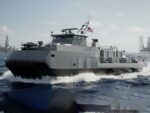India is reportedly analyzing a recovered Chinese PL-15E beyond-visual-range (BVR) air-to-air missile to support the development of its indigenous Astra Mk2 program. The effort reflects India’s strategic push to close the technological gap with China in advanced air combat systems by leveraging intelligence gained from adversary systems.
Recovered PL-15E Missile Under Scrutiny
According to multiple defense sources and corroborated by Indian media reports in late October 2025, a relatively intact Chinese PL-15E BVR air-to-air missile was recovered—possibly from an unexplained crash or interception incident near India’s northern border. The Indian Air Force (IAF), in collaboration with the Defence Research and Development Organisation (DRDO), has initiated a detailed technical analysis of the missile’s subsystems.
The PL-15E is the export variant of China’s primary long-range AAM (air-to-air missile), reportedly capable of ranges exceeding 145 km. It is equipped with an active electronically scanned array (AESA) radar seeker and dual-pulse solid-fuel motor—features that are of high interest to Indian engineers working on the Astra Mk2 program. While exact details of how the missile was obtained remain classified or speculative, open-source intelligence suggests it may have been retrieved from an incident involving Pakistan or via electronic warfare-induced malfunction.
Astra Mk2 Program Seeks Capability Leap
The Astra Mk1 has already entered limited service with the IAF and is integrated onto Su-30MKI platforms. However, its range (~110 km) and seeker technology lag behind newer Chinese and Western missiles like the PL-15 or AIM-120D AMRAAM. The Astra Mk2 aims to bridge this gap by incorporating:
- A dual-pulse solid rocket motor for extended range (~160–170 km)
- An AESA radar seeker for improved target acquisition in cluttered or jammed environments
- Enhanced electronic counter-countermeasures (ECCM) capabilities
- Reduced reaction time through improved datalink integration
The recovered PL-15E provides Indian engineers with valuable insights into how China has implemented these technologies at scale. In particular, DRDO is believed to be focusing on reverse-engineering aspects of the AESA seeker assembly and propulsion design.
Comparative Analysis: Astra Mk2 vs PL-15E
While both missiles fall into the class of long-range BVR AAMs designed for modern networked air combat environments, there are notable differences:
| Feature | Astra Mk2 (Projected) | PL-15E |
|---|---|---|
| Range | ~160–170 km | >145 km (claimed) |
| Seeker Type | AESA Radar Seeker | AESA Radar Seeker |
| Datalink Capability | Bilateral Datalink Planned | Bilateral Datalink Confirmed |
| Propulsion Type | Dual-Pulse Solid Rocket Motor | Dual-Pulse Solid Rocket Motor |
| Status | In Development / Testing Phase as of late 2025 | Export Variant Available; In Service with PLA-AF as base model (PL-15) |
This comparative study underscores India’s intent not just to achieve parity but potentially surpass certain capabilities through indigenous innovation informed by adversary benchmarks.
Tactical Implications for Regional Air Superiority Dynamics
The PLA Air Force fields advanced fighters like J-20s armed with domestic variants of the PL-15 series. These missiles give China a standoff advantage in BVR engagements across contested regions such as Ladakh or Arunachal Pradesh. By accelerating Astra Mk2 development using insights from captured enemy tech, India aims to neutralize this edge.
If successful, Astra Mk2 could be deployed across multiple fighter platforms including Su-30MKI, Tejas Mk1A/MkII, Rafale F3R/4 (with integration support), and potentially AMCA in future phases. This would allow India to field a distributed BVR capability resilient against jamming and capable of engaging high-value targets such as AEW&C aircraft at extended ranges.
Challenges Ahead: Integration and Indigenous Innovation Hurdles
The use of foreign hardware for reverse engineering carries both opportunities and risks:
- Spoofing or decoy elements embedded in export variants like PL-15E may mislead developers unless carefully validated.
- Divergence between export-grade components versus PLA-use variants could limit applicability.
- Sourcing domestic equivalents for high-frequency GaN-based AESA modules remains a bottleneck for DRDO labs.
- Datalink integration across diverse IAF platforms requires robust middleware protocols compliant with STANAG standards or equivalent indigenous frameworks.
The success of Astra Mk2 will depend not only on absorbing lessons from adversary tech but also on overcoming indigenous supply chain gaps—particularly in miniaturized RF electronics and thermal insulation materials used in high-speed missiles.
The Road Ahead: Trials Timeline and Deployment Prospects
The first guided trials for Astra Mk2 were conducted in late 2023 using a Su-30MKI testbed off Odisha’s coast. Further developmental tests are expected throughout late 2025 into early 2026 focusing on seeker lock-on performance under jamming conditions and terminal guidance accuracy against maneuvering targets.
If milestones are met as projected by DRDO officials during Aero India expos and parliamentary briefings earlier this year, limited series production could begin by mid-to-late 2026 under Bharat Dynamics Ltd (BDL). Full operational clearance might follow by early 2027 depending on integration timelines across frontline squadrons.
Synthesis: Strategic Leverage Through Technological Parity
This episode reflects an enduring trend where nations leverage battlefield recoveries or espionage windfalls to accelerate R&D cycles. For India’s defense ecosystem—still grappling with dependency on Russian-origin systems—the ability to decode advanced Chinese missiles offers both tactical insight and industrial stimulus.
If executed successfully without overreliance on reverse engineering alone, this initiative may signal India’s maturing capability in designing next-generation precision-guided munitions tailored for contested electromagnetic environments—a core requirement for future Indo-Pacific aerial dominance scenarios.










